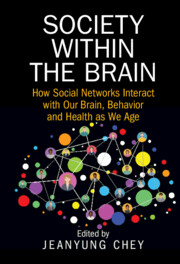Book contents
- Society within the Brain
- Society within the Brain
- Copyright page
- Dedication
- Contents
- Figures
- Tables
- Contributors
- Preface
- Introduction
- Part I Approaches to Society within the Brain
- Part II Society Interacting with Brain, Cognition, and Health in Late Life
- Chapter 5 The Life Course Approach to Cognitive Aging and Dementia
- Chapter 6 Enriched Social Connectedness and Brain Function
- Chapter 7 Psychoneuroimmunology Linking Social Isolation with Cognitive Aging
- Chapter 8 Loneliness and Psychological Health in Late Life
- Part III An Individual’s Cognitive Aging with Others: Key Findings, Issues, and Implications
- Index
- References
Chapter 5 - The Life Course Approach to Cognitive Aging and Dementia
from Part II - Society Interacting with Brain, Cognition, and Health in Late Life
Published online by Cambridge University Press: 28 September 2023
- Society within the Brain
- Society within the Brain
- Copyright page
- Dedication
- Contents
- Figures
- Tables
- Contributors
- Preface
- Introduction
- Part I Approaches to Society within the Brain
- Part II Society Interacting with Brain, Cognition, and Health in Late Life
- Chapter 5 The Life Course Approach to Cognitive Aging and Dementia
- Chapter 6 Enriched Social Connectedness and Brain Function
- Chapter 7 Psychoneuroimmunology Linking Social Isolation with Cognitive Aging
- Chapter 8 Loneliness and Psychological Health in Late Life
- Part III An Individual’s Cognitive Aging with Others: Key Findings, Issues, and Implications
- Index
- References
Summary
Sources of resilience against neurodegenerative diseases, such as cognitive reserve, have been identified as modifiable factors that can prevent the manifestation of clinical dementia. A recent trend in dementia research has employed the concepts of reserve and resilience in the context of a lifespan to develop a life course approach, which integrates the risks of dementia and provides prevention strategies throughout life. This chapter introduces the life course approach to understanding dementia, which is a scientific discipline based on the span of life involving biology, psychology, and the social sciences in a single integrated causal structure to provide a framework to organize the multifactorial process involved in human aging and dementia. The cognitive reserve hypothesis and essential studies validating the theory are introduced; these report the moderating effects of literacy and formal education in dementia manifestation. Brain maintenance, another important component in understanding the resistance to brain aging and neurodegenerative diseases, is also discussed. Lastly, the chapter proposes a hypothetical pathway model to help understand the complex interaction between social relation and brain aging underlying the moderation that could either reduce or increase the risks of dementia.
Keywords
- Type
- Chapter
- Information
- Society within the BrainHow Social Networks Interact with Our Brain, Behavior and Health as We Age, pp. 119 - 140Publisher: Cambridge University PressPrint publication year: 2023



